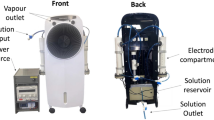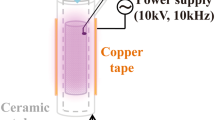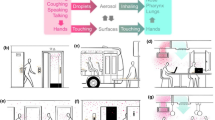Abstract
A novel high-voltage electrostatics corona ions pre-charger apparatus and methods were invented earlier by Hamade related to treat various types of receptors such as but not limited to electret polymer, air filters, particulates, catalytic converters, bioaerosols, fluids, pollutants, virus, and bacteria. It is shown in this article that his work led to the construction of various prototype chargers, customized differently for each type of a receptor. In particular his recent development of biological matter corona charger (BMCC) prototype related to expose, treat, sanitize, and disinfect bioaerosols, virus, bacteria, and contaminated fluids and blood such as human immunodeficiency virus (HIV) - acquired immune deficiency syndrome (AIDS). It is shown in this paper that each previous investigated research contemplated ionized corona charger attendant to a charging process and the corona, imparts and provides enough treatment charges to receptors including the aforementioned receptors. Researchers often relied on adopting prior corona charger methods that do not necessarily and effectively solve the problems associated with them or utilize them for optimum treatment effect. The inventor exhaustively studied the characteristics of corona discharge, and has found that the greatest difficulty in corona discharge has to do with the maintenance of the corona, particularly when the receptor is being charged. This is due to variations in either the dielectric value between the corona electrode and a grounded base or flaws in the design as the receptor passes there between suppressing or hindering corona and its effectiveness. What is needed in-the-art is an apparatus and method to achieve maximum possible charge on a receptor, a charge order of magnitude greater than that used by other investigators. This often requires customizing each apparatus and method and does not just merely use one type of a charger to satisfy all applications. To satisfy this need, we build a low cost prototype BMCC that generates self-sustaining charge corona, eliminates many previous design flaws such as spark over, and make it ready for testing remotely or with apparatus.
Similar content being viewed by others
Change history
01 June 2020
The original version of this article unfortunately contained outdated email address in footing, page 112. The updated email address is given below.
References
HAMADE T A. Electrostatic charging apparatus and method: USA 5 012 094 [P]. 1991–04–30.
HAMADE T A. Electrically stimulated catalytic converter apparatus, and method of using same: USA 8 544 257 [P]. 2013–10–01.
HAMADE T A. Electrically stimulated catalytic converter apparatus, and method of using same: CN101711445A [P]. 2010–06–02.
RYU S W. Molecular virology of human pathogenic viruses [M]. USA: Elsevier Press, 2016: 205–317.
KAALI S, SCHWOLSKY P. Electrically conductive methods and systems for treatment of blood and other body fluids and/or synthetic fluids with electric forces: USA 5 139 684 [P]. 1992–08–08.
HYUN J, LEE S G, HWANG J. Application of corona discharge-generated air ions for filtration of aerosolized virus and inactivation of filtered virus [J]. Journal of Aerosol Science, 2017, 107: 31–40.
LEE C, KIM J, YOON J. Inactivation of MS2 bacteriophage by streamer corona discharge in water [J]. Chemosphere, 2011, 82: 1135–1140.
SINGH R K, PHILIP L, RAMANUJAM S. Rapid degradation, mineralization and detoxification of pharmaceutically active compounds in aqueous solution during pulsed corona discharge treatment [J]. Water Research, 2017, 121: 20–36.
STEPCZNSKA M. Research of biocidal effect of corona discharges on poly (lactic acid) packaging films [J]. Journal of Food Engineering, 2014, 126(1): 56–61.
WHITE H J. Industrial electrostatic precipitation [M]. USA: Addison Wesley Publishing Company, 1963: 126–136.
HILCZER B, MALECKI J. Studies in electrical and electronic engineering Vol. 14 [M]. USA: Elsevier Press, 1986: 275–313.
MOORE A D. Electrostatics and its applications [M]. New York: John Wiley and Sons, 1973: 1–480.
MASUDA, S, SUGITA N. High-efficiency electrostatic air filter device: USA 4357150 [P]. 1982–12–02.
JAISINGHANI R A, HAMADE T A. Effect of relative humidity on electrically stimulated filter performance [J]. Air Repair, 1987, 37(7): 823–828.
JAISINGHANI R A, HAMADE T A, HAWLEY C W. Electrically stimulated filter method and apparatus: USA 4 853 005 [P]. 1989–08–01.
JAISINGHANI R A, HAMADE T A. Environmental effects on electrically stimulated air filtration performance [C]//Hershey Conference sponsored by APCA, Fiber Society, Filtration Society. USA: APCA, 1985.
KUPLICKI S J. An investigation of corona based precharger grid design experiments to the particle charging of an aerosol [D]. USA, Michigan: University of Detroit, 1994.
HAMADE T A. Novel electrically stimulated catalytic converter prototype for replacement of conventional auto exhaust emission converters [J]. Journal of Shanghai Jiao Tong University, 2018, 23(1): 85–96.
PICKWICK W L. New electrostatic corona discharge method for enhancing polymer electrets [D]. USA, Michigan: University of Detroit, 1990.
SESSLER G M. Electrets [M]. 2nd ed. USA, New York: Springer-Verlag Press, 1987: 1–450.
KALLARD T. Electret devices for air pollution control [M]. USA, New York: Optosonic Press, 1972: 1–10.
HAMADE T A, PICKWICK W L. Electrostatic processing of polymer electrets Vol. 19 [M]. USA: ASME, MD, 1990: 161–176.
Acknowledgement
The author expresses his thanks to HUA Yihe and LI Zhe, junior students at University of Michigan-Shanghai Jiao Tong University Joint Institute, Shanghai Jiao Tong University, for their assistance in writing this paper and performing literature search (Refs. [4, 10-13]) that was essential to demonstrate the advantages of our corona ions charger in treating receptor over prior art.
Author information
Authors and Affiliations
Corresponding author
Rights and permissions
About this article
Cite this article
Hamade, T.A. Novel Application of High Voltage Electrostatics Corona Ions Discharge Related to Treatment, Sanitization and Disinfection of Biological Matter Such HIV-AIDS Infected Blood. J. Shanghai Jiaotong Univ. (Sci.) 23, 112–121 (2018). https://doi.org/10.1007/s12204-018-1916-y
Received:
Published:
Issue Date:
DOI: https://doi.org/10.1007/s12204-018-1916-y
Key words
- high voltage
- corona ions discharge
- disinfection
- acquired immune deficiency syndrome (AIDS)
- infected blood
- electret
- emission catalytic converter




